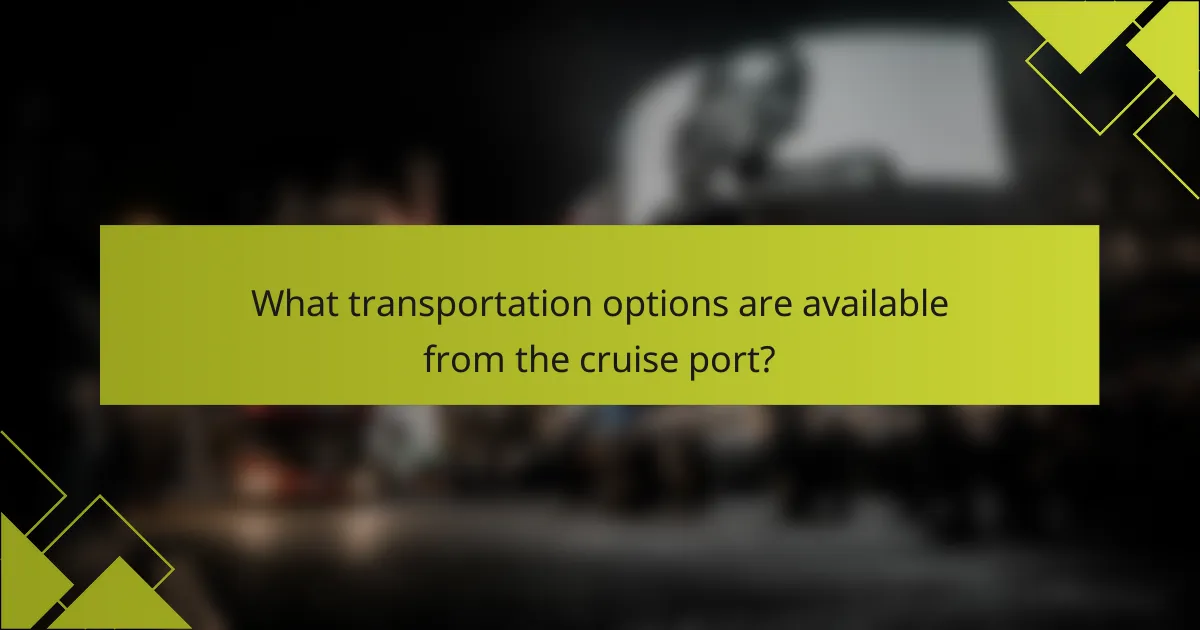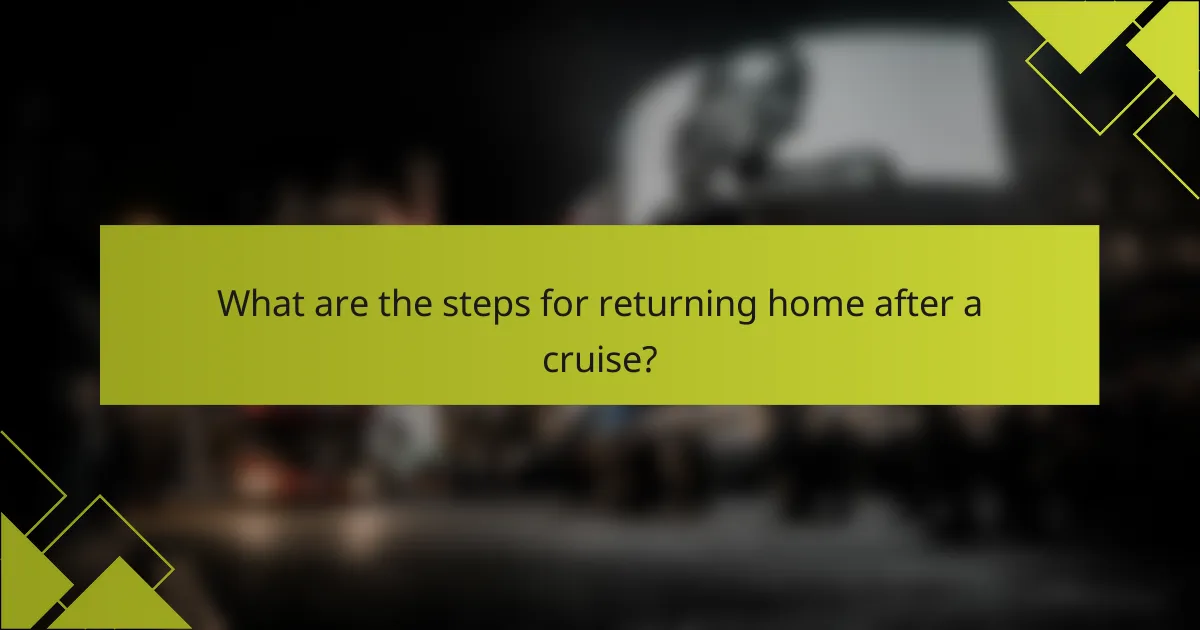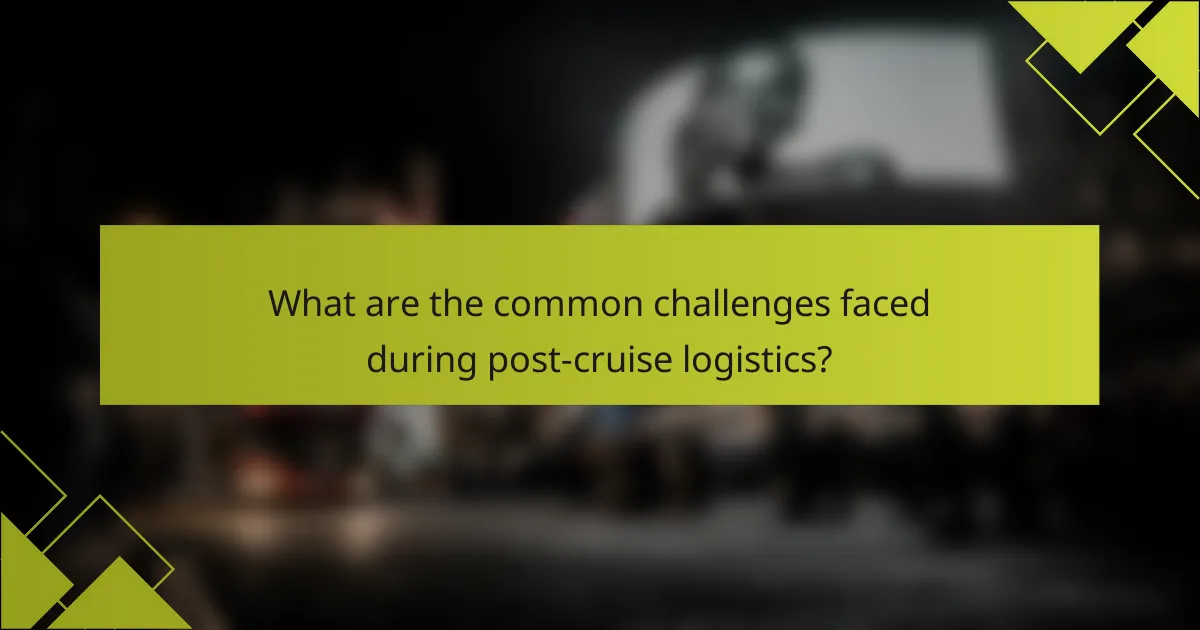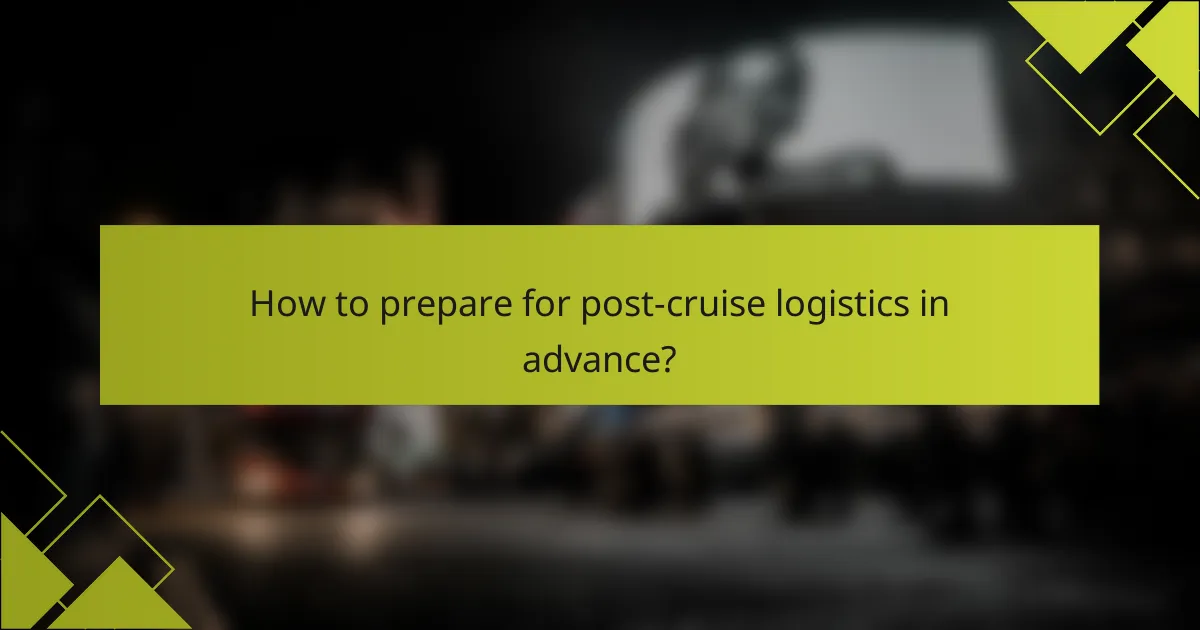After your cruise, navigating post-cruise logistics is essential for a smooth transition back home. From various transportation options like shuttles and taxis to managing luggage and customs, understanding these steps can enhance your travel experience. By evaluating your needs and preferences, you can ensure a hassle-free journey from the port to your next destination.

What transportation options are available from the cruise port?
After disembarking from your cruise, several transportation options are available to help you reach your next destination. These include shuttle services, taxis, public transport, private car rentals, and airport transfer services, each with its own advantages and considerations.
Shuttle services
Shuttle services are often provided by cruise lines or local companies, offering convenient transportation directly from the port to popular destinations, hotels, or airports. These shuttles typically run on a set schedule and can be booked in advance or upon arrival.
Prices for shuttle services can vary, generally ranging from $15 to $30 per person, depending on the distance and destination. It’s advisable to check with your cruise line for any included shuttle options or recommended providers.
Taxi and rideshare services
Taxis and rideshare services like Uber and Lyft are widely available at most cruise ports, providing flexible and direct transportation to your desired location. Taxis usually have a flat rate to certain areas, while rideshare fares can fluctuate based on demand.
Expect to pay around $20 to $50 for a taxi or rideshare to nearby hotels or attractions. Always confirm the fare before starting your trip, especially with taxis, to avoid unexpected charges.
Public transportation
Public transportation options, such as buses and trains, are often accessible from cruise ports, offering a budget-friendly way to travel. Many ports are well-connected to local transit systems, making it easy to reach city centers or other attractions.
Fares for public transport typically range from $1 to $5, depending on the city and distance. Be sure to check the local transit schedules and routes ahead of time to plan your journey effectively.
Private car rentals
Renting a car can provide the most flexibility for travelers looking to explore the area at their own pace. Major car rental companies usually have locations near cruise ports, allowing for easy pick-up and drop-off.
Rental prices can vary widely, often starting around $30 per day, plus fuel and insurance costs. Make sure to review local driving regulations and parking options at your destination before renting.
Airport transfer services
Airport transfer services are specifically designed to transport passengers from the cruise port to nearby airports. These services can be pre-arranged through various companies, offering shared or private rides based on your preference.
Costs for airport transfers typically range from $25 to $100, depending on the type of service and distance to the airport. Booking in advance can often secure better rates and ensure availability during peak travel times.

How to choose the best transportation method after a cruise?
Selecting the best transportation method after a cruise involves evaluating factors such as cost, travel time, and convenience. Consider your destination, budget, and personal preferences to make an informed decision that suits your needs.
Cost comparison
When comparing transportation costs, consider options like taxis, shuttles, public transit, and rideshares. Taxis and rideshares may charge between $20 to $100 depending on distance, while shuttles often provide a lower-cost alternative, typically ranging from $15 to $50 per person.
Public transportation can be the most economical choice, with fares usually under $10, but it may require more time and effort. Always check for any additional fees, such as luggage charges or tolls, that could affect the total cost.
Travel time considerations
Travel time varies significantly based on the transportation method chosen. Taxis and rideshares usually offer the fastest service, often taking 20 to 30 minutes to reach major destinations. In contrast, shuttles may take longer, especially if they make multiple stops.
Public transportation can also extend travel time, potentially requiring an hour or more depending on connections and waiting times. Factor in your schedule and any time-sensitive commitments when selecting your transportation method.
Convenience and accessibility
Convenience is a key factor when choosing transportation after a cruise. Taxis and rideshares provide door-to-door service, making them ideal for travelers with heavy luggage or those needing quick access to their accommodations.
Shuttles may require you to walk a short distance to a designated pickup point, which can be less convenient. Public transportation can be challenging for those with mobility issues or large bags, so assess your personal needs before deciding.

What are the steps for returning home after a cruise?
Returning home after a cruise involves several key steps, including collecting your luggage, navigating customs and immigration, and planning your route home. Each of these steps requires careful attention to ensure a smooth transition from vacation back to everyday life.
Collecting luggage
After disembarking, the first task is to collect your luggage from the designated area. Typically, luggage is placed in a specific terminal or area based on your cruise line, and you will need to locate your bags among many others.
To streamline this process, keep your luggage tags visible and organized. If you have any special items or fragile luggage, consider marking them clearly to avoid confusion. Arriving early can also help you avoid long lines.
Customs and immigration process
Once you have your luggage, you will proceed to customs and immigration. This process usually involves presenting your passport and any required documentation, such as customs declarations for items purchased abroad.
Be prepared for potential inspections, especially if you are bringing back items that may be subject to duties or restrictions. Familiarize yourself with the customs regulations of your home country to avoid surprises, as these can vary significantly.
Planning your route home
After clearing customs, it’s time to plan your route home. Consider the transportation options available, such as taxis, shuttles, or public transit, depending on the distance to your home and your budget.
Check for any pre-arranged transportation services offered by your cruise line, as these can simplify your journey. If using public transport, review schedules and routes in advance to minimize delays. Always allow extra time for unexpected events, especially if you have a flight to catch.

What follow-up activities should be considered post-cruise?
Post-cruise follow-up activities are essential for reflecting on your journey and planning future adventures. Engaging in these activities can enhance your travel experience and help you make the most of your time after returning home.
Reviewing cruise experience
Taking time to review your cruise experience allows you to evaluate what you enjoyed and what could be improved. Consider aspects such as the quality of service, onboard activities, and excursions. Jotting down your thoughts can help you remember details for future reference.
Creating a simple rating system for various elements of your cruise can be beneficial. For example, rate dining options, entertainment, and cabin comfort on a scale of 1 to 5. This structured feedback can guide your decisions for future cruises.
Sharing travel experiences
Sharing your travel experiences with friends and family can be a rewarding way to relive your cruise. Consider posting photos and highlights on social media platforms or writing a blog post detailing your adventures. This not only keeps your memories alive but may also inspire others to travel.
Participating in travel forums or groups can further enhance your sharing experience. Engaging with fellow travelers allows you to exchange tips and recommendations, enriching your knowledge and network.
Planning future trips
Planning future trips is an exciting follow-up activity that can keep the travel spirit alive. Start by reflecting on the destinations you enjoyed most during your cruise and consider similar itineraries or new locations. Researching potential cruises can help you find the best options that fit your interests and budget.
Creating a travel wishlist can be a practical approach. List destinations, activities, and experiences you want to explore. Setting a timeline for your next trip can also help you stay motivated and organized as you prepare for your next adventure.

What are the common challenges faced during post-cruise logistics?
Post-cruise logistics often involve several challenges that can complicate the return journey home. Key issues include timing problems, unexpected delays, and lost luggage, all of which can lead to stress and inconvenience for travelers.
Timing issues
Timing issues can arise when disembarking from the cruise ship, especially if there are scheduled flights or other transportation connections. It’s crucial to allow ample time between the cruise’s end and any subsequent travel plans, ideally a few hours to a full day, to accommodate potential delays.
Consider booking transportation that offers flexibility, such as shuttle services that run regularly or rental cars with no strict return times. This can help mitigate the stress of tight schedules and ensure a smoother transition back home.
Unexpected delays
Unexpected delays can occur due to various factors, including customs processing, traffic conditions, or weather-related issues. These delays can significantly impact your travel plans, particularly if you have connecting flights or other time-sensitive arrangements.
To prepare for such delays, monitor real-time traffic updates and allow for extra travel time. Having a backup plan, such as alternative transportation options or accommodations, can also provide peace of mind in case of unforeseen circumstances.
Lost luggage
Lost luggage is a common concern during post-cruise logistics, particularly when transferring between different modes of transportation. To minimize the risk, label your bags clearly and keep essential items, such as medications and travel documents, in your carry-on.
If your luggage is lost, report it immediately to the airline or transportation provider and keep a record of your claim. Many companies have policies for compensation, so understanding your rights can help you navigate the situation more effectively.

How to prepare for post-cruise logistics in advance?
Preparing for post-cruise logistics involves planning your transportation from the port, organizing your return home, and scheduling any follow-up activities. By addressing these elements ahead of time, you can ensure a smoother transition back to your daily routine.
Transportation from the port
Arranging transportation from the port is crucial for a seamless post-cruise experience. Options typically include taxis, shuttles, rental cars, or public transport, depending on your destination and budget. Researching these options in advance can save you time and stress on disembarkation day.
Consider booking a shuttle service or taxi in advance, especially during peak travel seasons when demand is high. If you prefer public transport, check local schedules and routes to ensure they align with your arrival time.
Returning home
Returning home after your cruise requires careful planning to avoid delays. If you have a flight, aim to book it for later in the day to allow ample time for disembarkation and transportation. Many cruise lines recommend at least a few hours between your ship’s arrival and your flight departure.
For those traveling by car, ensure your vehicle is parked in a secure location and consider potential traffic conditions on your return. If you’re using a rideshare service, confirm the pickup location in advance to avoid confusion.
Follow-up activities
Follow-up activities can enhance your cruise experience and help you reflect on your trip. Consider scheduling a day to unpack, sort through photos, and share your experiences with friends or family. This can also be a good time to write reviews or provide feedback to the cruise line.
Additionally, if you purchased any excursions or experiences during your cruise, ensure you follow up on any promised materials or photos. Keeping a checklist of these activities can help you stay organized and make the most of your post-cruise time.
